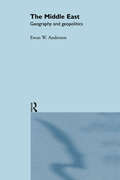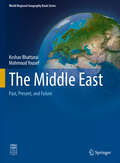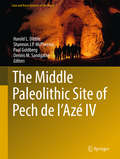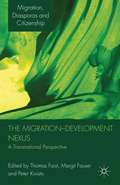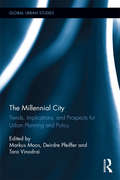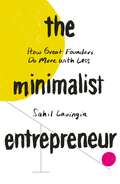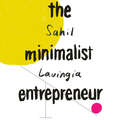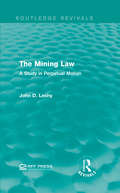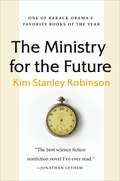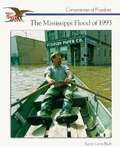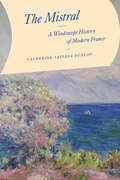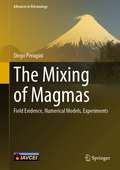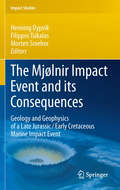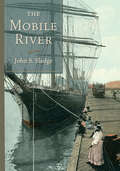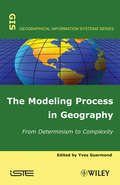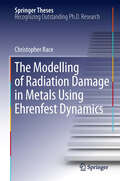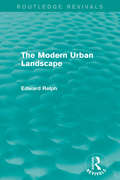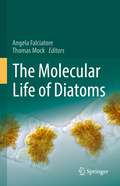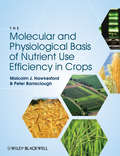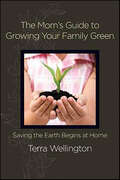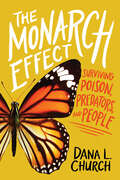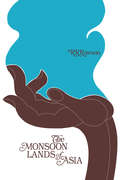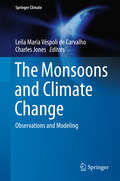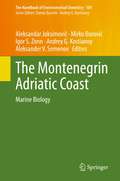- Table View
- List View
The Middle East: Geography and Geopolitics
by Ewan W. AndersonAlthough the focus is on geopolitics rather than regional geography, the aim of the book is to provide a reorientation, while maintaining an essential continuity with W. B. Fisher’s book of the same name, the seventh edition of which was published in 1978. A comprehensive account is provided of the physical and human geography of the region and, in this, certain sections from Fisher’s book have been retained. Based on the geography, a geopolitical assessment is then made of the states of the Middle East and of the major issues, such as water and conflict, which illustrate the interplay of geography and politics. With comprehensive illustrations, this is a lively and much-needed book, based upon a well-respected work, providing an excellent synopsis of the complexities that make the Middle East such an intriguing and important global region.
The Middle East: Past, Present, and Future (World Regional Geography Book Series)
by Keshav Bhattarai Mahmoud YousefThe Middle East and North Africa (MENA) region stands as a remarkable crossroads of tradition and modernity, shaped by millennia of history under empires, colonial powers, and global influences. This book unpacks the intricate dynamics of the region, examining how historical resource exploitation, border manipulation, and cultural impositions have profoundly impacted its languages, traditions, and geopolitical identity. The rich tapestry of Arabic, Farsi, Kurdish, and regional dialects reflects a deep cultural resilience that has resisted globalization, often fueled anti-Western sentiments and prioritized the preservation of heritage over rapid economic development. Central to the region’s geopolitical importance is its vast oil wealth, which has positioned MENA as a cornerstone of the global energy market and a continuous focus of Western interest. This book explores how oil exploitation has economically empowered the region while simultaneously fostering political tension, external interventions, and instability. As the global shift toward green technologies accelerates, the book examines how this transition might redefine MENA’s role in the global energy market, offering both challenges and opportunities for transformation. These dynamics unfold against the backdrop of water scarcity and a scorching, inhospitable climate that further complicates the region’s path forward. Grounded in real-life case studies and an interdisciplinary blend of historical, cultural, and economic analysis, this book offers an unparalleled exploration of the MENA region’s past, present, and future in the context of advanced technological development. Co-authored by a Palestinian native, it brings a unique perspective by dissecting ongoing identity crises through unbiased insights and true-life conversations with individuals who have embraced diverse religious and political ideologies. By intertwining these narratives with the region’s deeply rooted cultural practices, the book presents a compelling human lens to understand MENA's complexities. This rare and thought-provoking study seamlessly balances traditional and modern perspectives, emphasizing the MENA region’s pivotal role at the intersection of Western powers and the Global South. For readers seeking to grasp the intricate dynamics of a region that continues to influence and adapt to an ever-changing global order, this book serves as an indispensable resource.
The Middle Paleolithic Site of Pech de l'Azé IV
by Paul Goldberg Harold L. Dibble Dennis M. Sandgathe Shannon J. McPherronThis book provides comprehensive information on the materials excavated at Pech de l’Azé IV, both by the original excavator François Bordes in the 1970s, and more recently by the authors and their scientific team. Applying a range of new excavation and analytical techniques, it presents detailed material on the formation of the site, its chronology and the nature of the hominin occupations. Pech de l’Azé IV is part of a complex of Lower and Middle Paleolithic cave sites in the Dordogne Valley of southwestern France. Although this region is well known for its rich concentration of Paleolithic sites since the mid-19th century and many of the sites have been repeatedly excavated, no detailed studies have fully documented the stone tool technology and faunal remains or the changes in them over time. The site was regularly occupied by groups of Neanderthals from approximately 100,000 to 40,000 years ago, during which time global-scale changes transformed the region from a relatively warm climate (similar to today’s) to a very cold, glacial one. The site provides valuable insights into changes in Neanderthal behavior that reflect, at least in part, their adaptation to changes in the environment and the availability of important resources, such as prey species.
The Migration-Development Nexus
by Peter Kivisto Margit Fauser Thomas FaistThis book examines current policy discussions around the migration-development nexus and subjects them to rigorous conceptual and empirical criticism through a transnational lens, placing the current re-discovery of migrants as agents of development nexus into theoretical and historical perspective.
The Millennial City: Trends, Implications, and Prospects for Urban Planning and Policy (Global Urban Studies)
by Markus Moos Deirdre Pfeiffer Tara VinodraiMillennials have captured our imaginaries in recent years. The conventional wisdom is that this generation of young adults lives in downtown neighbourhoods near cafes, public transit and other amenities. Yet, this depiction is rarely unpacked nor problematized. Despite some commonalities, the Millennial generation is highly diverse and many face housing affordability and labour market constraints. Regardless, as the largest generation following the post-World War II baby boom, Millennials will surely leave their mark on cities. This book assesses the impact of Millennials on cities. It asks how the Millennial generation differs from previous generations in terms of their labour market experiences, housing outcomes, transportation decisions, the opportunities available to them, and the constraints they face. It also explores the urban planning and public policy implications that arise from these generational shifts. This book offers a generational lens that faculty, students and other readers with interest in the fields of urban studies, planning, geography, economic development, demography, or sociology will find useful in interpreting contemporary U.S. and Canadian cities. It also provides guidance to planners and policymakers on how to think about Millennials in their work and make decisions that will allow all generations to thrive.
The Minimalist Entrepreneur: How Great Founders Do More with Less
by Sahil Lavingia'Pay attention' - Jason Fried, founder and CEO of Basecamp, bestselling author of ReWork A revolutionary roadmap for building startups that go the distance Cracks are forming in the myth of the VC-funded, IPO-driven billion-dollar company. They're unprofitable, unethical and unsustainable - so why bother chasing unicorns? The Minimalist Entrepreneur is the manifesto for a new generation of founders who would rather build great companies than big ones. Packed with hard-won, battle-tested lessons from Lavingia's own journey of building Gumroad, The Minimalist Entrepreneur teaches founders how to start from anywhere to build any kind of software-enabled business. You will learn how to: resist investments that set you up to fail; run a tight ship amid the rise of the gig economy and remote work; develop and release products without failing fast or often; get to profitability and stay there. The Minimalist Entrepreneur offers essential knowledge for every founder aspiring to build a business worth building.
The Minimalist Entrepreneur: How Great Founders Do More with Less
by Sahil Lavingia'Pay attention' - Jason Fried, founder and CEO of Basecamp, bestselling author of ReWork A revolutionary roadmap for building startups that go the distance Cracks are forming in the myth of the VC-funded, IPO-driven billion-dollar company. They're unprofitable, unethical and unsustainable - so why bother chasing unicorns? The Minimalist Entrepreneur is the manifesto for a new generation of founders who would rather build great companies than big ones. Packed with hard-won, battle-tested lessons from Lavingia's own journey of building Gumroad, The Minimalist Entrepreneur teaches founders how to start from anywhere to build any kind of software-enabled business. You will learn how to: resist investments that set you up to fail; run a tight ship amid the rise of the gig economy and remote work; develop and release products without failing fast or often; get to profitability and stay there. The Minimalist Entrepreneur offers essential knowledge for every founder aspiring to build a business worth building.
The Mining Law: A Study in Perpetual Motion (Routledge Revivals)
by John D. LeshyOriginally published in 1987, John D. Leshy presents this scholarly study of the 1872 Mining Law as a legal treatise and history of mining in the West from the point of view of mineral exploration and production. This mining law governed the United States mining practice yet had never been changed. The Mining Law attempts to highlight the role of policy and government as well as the more obscure elements of the law which complicated mining practice in the eighties. This title will be of interest to students of Environmental Studies and policy makers.
The Ministry for the Future: A Novel
by Kim Stanley RobinsonONE OF BARACK OBAMA&’S FAVORITE BOOKS OF THE YEAR&“The best science-fiction nonfiction novel I&’ve ever read.&” —Jonathan Lethem "If I could get policymakers, and citizens, everywhere to read just one book this year, it would be Kim Stanley Robinson&’s The Ministry for the Future." —Ezra Klein (Vox)The Ministry for the Future is a masterpiece of the imagination, using fictional eyewitness accounts to tell the story of how climate change will affect us all. Its setting is not a desolate, postapocalyptic world, but a future that is almost upon us. Chosen by Barack Obama as one of his favorite books of the year, this extraordinary novel from visionary science fiction writer Kim Stanley Robinson will change the way you think about the climate crisis."One hopes that this book is read widely—that Robinson&’s audience, already large, grows by an order of magnitude. Because the point of his books is to fire the imagination."―New York Review of Books"If there&’s any book that hit me hard this year, it was Kim Stanley Robinson&’s The Ministry for the Future, a sweeping epic about climate change and humanity&’s efforts to try and turn the tide before it&’s too late." ―Polygon (Best of the Year) "Masterly." —New Yorker"[The Ministry for the Future] struck like a mallet hitting a gong, reverberating through the year ... it&’s terrifying, unrelenting, but ultimately hopeful. Robinson is the SF writer of my lifetime, and this stands as some of his best work. It&’s my book of the year." —Locus"Science-fiction visionary Kim Stanley Robinson makes the case for quantitative easing our way out of planetary doom." ―Bloomberg Green
The Mississippi Flood of 1993 (Cornerstones of Freedom)
by Karin Luisa BadtTens of thousands of families in nine states across the Midwest were forced to abandon their homes that summer. The Mississippi River and its tributaries (the smaller rivers that flow into a large river) were swollen from months of rain.
The Mistral: A Windswept History of Modern France
by Catherine Tatiana DunlopAn in-depth look at the hidden power of the mistral wind and its effect on modern French history. Every year, the chilly mistral wind blows through the Rhône valley of southern France, across the Camargue wetlands, and into the Mediterranean Sea. Most forceful when winter turns to spring, the wind knocks over trees, sweeps trains off their tracks, and destroys crops. Yet the mistral turns the sky clear and blue, as it often appears in depictions of Provence. The legendary wind is central to the area’s regional identity and has inspired artists and writers near and far for centuries. This force of nature is the focus of Catherine Dunlop’s The Mistral, a wonderfully written examination of the power of the mistral wind, and in particular, the ways it challenged central tenets of nineteenth-century European society: order, mastery, and predictability. As Dunlop shows, while the modernizing state sought liberation from environmental realities through scientific advances, land modification, and other technological solutions, the wind blew on, literally crushing attempts at control, and becoming increasingly integral to regional feelings of place and community.
The Mixing of Magmas: Field Evidence, Numerical Models, Experiments (Advances in Volcanology)
by Diego PeruginiThis book provides a common theoretical and practical basis to the multifaceted nature of magma mixing. This process represents a fundamental phenomenon both in the evolution of igneous rocks and in triggering explosive volcanic eruptions. The topic is attacked surgically merging field evidence, numerical models, and experiments in order to draw the most complete picture about this natural process. Arguments are discussed in the light of Chaos Theory and Fractal Geometry as new tools to understand the role of magma mixing as a fundamental petrological and volcanological process. The book is intended to be a source of information and a stimulus for new ideas in students, young and possibly more experienced researches.
The Mjølnir Impact Event and its Consequences: Geology and Geophysics of a Late Jurassic/Early Cretaceous Marine Impact Event (Impact Studies)
by Morten Smelror Henning Dypvik Filippos TsikalasThe Mjølnir impact structure was recognized in 1993 and included in the Earth Impact Database in 1996, based on the discoveries of unequivocal meteorite impact indicators such as shocked quartz, Ir-enrichments, possible glass remnants, fragments of nickel-rich iron oxides, in addition to the convincing complex crater shape of the structure. This book presents the geological and geophysical history of the Barents Sea region along with the discovery of the Mjølnir impact crater. We place the Mjølnir event into the geological framework of the region and present elaborative numerical models of its formation and associated tsunami generation. The book represents an update and synthesis as well as the complete compilation of the Mjølnir crater studies.
The Mobile River
by John S. Sledge“A fine, fascinating book. John S. Sledge introduces us to four centuries worth of heroes and rogues on one incredible American river.” —Winston Groom, New York Times–bestselling author of Forrest GumpThe Mobile River presents the first-ever narrative history of this important American watercourse. Inspired by the venerable Rivers of America series, John S. Sledge weaves chronological and thematic elements with personal experiences and more than sixty color and black-and-white images for a rich and rewarding read.Previous historians have paid copious attention to the other rivers that make up the Mobile’s basin, but the namesake stream along with its majestic delta and beautiful bay have been strangely neglected. In an attempt to redress the imbalance, Sledge launches this book with a first-person river tour by “haul-ass boat.” Along the way he highlights the four diverse personalities of this short stream—upland hardwood forest, upper swamp, lower swamp, and harbor.In the historical saga that follows, readers learn about colonial forts, international treaties, bloody massacres, and thundering naval battles, as well as what the Mobile River’s inhabitants ate and how they dressed through time. A barge load of colorful characters is introduced, including Native American warriors, French diplomats, British cartographers, Spanish tavern keepers, Creole women, steamboat captains, African slaves, Civil War generals and admirals, Apache prisoners, hydraulic engineers, stevedores, banana importers, Rosie Riveters, and even a few river rats subsisting off the grid—all of them actors in a uniquely American pageant of conflict, struggle, and endless opportunity along a river that gave a city its name.“Sledge brilliantly explores the myriad ways human history has entwined with the Mobile River.” —Gregory A. Waselkov, author of A Conquering Spirit
The Mobilities of Ships
by Anyaa Anim-Addo, William Hasty and Kimberley PetersWe live in a world that is ever on the move, as is increasingly recognised within research on mobilities. Yet studies of mobility have failed to ‘go to sea’ with the same enthusiasm as mobilities ashore. When we consider mobility, we most often examine those movements that evidently form part of our everyday lives. We forget to look outwards to the sea. Yet ships have played – and continue to play – a significant role in shaping socio-cultural, political and economic life. This book turns our attention to the manifold mobilities that occur at sea through an exploration of the mobilities of ships themselves as well as the movements of objects, subjects and ideas that are mobilised by ships. The Mobilities of Ships brings together seven chapters that tack through unexplored waters and move between diverse case studies, including pirate ships, naval vessels and luxury yachts. In so doing, The Mobilities of Ships offers a rich insight into the world of shipping mobilities past and present.This book was published as a special issue of Mobilities.
The Modeling Process in Geography: From Determinism to Complexity
by Yves GuermondThis title focuses on the evolution of the modeling process and on new research perspectives in theoretical and applied geography, as well as spatial planning. In the last 50 years, the achievements of spatial analysis models opened the way to a new understanding of the relationship between society and geographical space. In this book, these models are confronted by the real conditions of territorial prospect, regional dynamism, cultural policy, HMO, and spatial segregation. This confrontation takes into account the instability of social behavior and the permanence of partial determinist trajectories.
The Modelling of Radiation Damage in Metals Using Ehrenfest Dynamics
by Christopher RaceAtomistic simulations of metals under irradiation are indispensable for understanding damage processes at time- and length-scales beyond the reach of experiment. Previously, such simulations have largely ignored the effect of electronic excitations on the atomic dynamics, even though energy exchange between atoms and electrons can have significant effects on the extent and nature of radiation damage. This thesis presents the results of time-dependent tight-binding simulations of radiation damage, in which the evolution of a coupled system of energetic classical ions and quantum mechanical electrons is correctly described. The effects of electronic excitations in collision cascades and ion channeling are explored and a new model is presented, which makes possible the accurate reproduction of non-adiabatic electronic forces in large-scale classical molecular dynamics simulations of metals.
The Modern Urban Landscape (Routledge Revivals)
by Edward RelphFirst published in 1987, this book provides a wide-ranging account of how modern cities have come to look as they do — differing radically from their predecessors in their scale, style, details and meanings. It uses many illustrations and examples to explore the origins and development of specific landscape features. More generally it traces the interconnected changes which have occurred in architecture and aesthetic fashions, in planning, in economic and social conditions, and which together have created the landscape that now prevails in most of the cities of the world. This book will be of interest to students of architecture, urban studies and geography.
The Molecular Life of Diatoms
by Angela Falciatore Thomas MockDiatoms are the most species rich group of algae, and they contribute about 20% of annual global carbon fixation. They play major roles in ocean food webs and global biogeochemical cycles. They are also a target of the biotechnology industry because of their nano-patterned silica cell wall and high lipid content. Diatoms have received increasing attention as more genomes became available and because of the development of genome editing tools such as the CRISPR/Cas9 technology, which has made diatoms as genetically tractable as well-established biological model species. This book provides an overview on diatom molecular biology. It brings together international leading experts in the field to discuss the latest data and developments from genes to ecosystems. As the understanding of diatoms is currently experiencing a step change, it is critical to allow for synergistic approaches on diverse aspects of diatom biology and evolution. The books offers fundamental insights into the molecular life of diatoms; at the same time new scientific concepts are developed based on the application of the latest molecular tools and genomic information to explore the fascinating lifestyle of diatoms.
The Molecular and Physiological Basis of Nutrient Use Efficiency in Crops
by Malcolm J. Hawkesford Peter BarracloughEfforts to increase efficient nutrient use by crops are of growing importance as the global demand for food, fibre and fuel increases and competition for resources intensifies. The Molecular and Physiological Basis of Nutrient Use Efficiency in Crops provides both a timely summary of the latest advances in the field as well as anticipating directions for future research. The Molecular and Physiological Basis of Nutrient Use Efficiency in Crops bridges the gap between agronomic practice and molecular biology by linking underpinning molecular mechanisms to the physiological and agronomic aspects of crop yield. These chapters provide an understanding of molecular and physiological mechanisms that will allow researchers to continue to target and improve complex traits for crop improvement.Written by leading international researchers, The Molecular and Physiological Basis of Nutrient Use Efficiency in Crops will be an essential resource for the crop science community for years to come.Special Features:coalesces current knowledge in the areas of efficient acquisition and utilization of nutrients by crop plants with emphasis on modern developments addresses future directions in crop nutrition in the light of changing climate patterns including temperature and water availability bridges the gap between traditional agronomy and molecular biology with focus on underpinning molecular mechanisms and their effects on crop yield includes contributions from a leading team of global experts in both research and practical settings
The Mom's Guide to Growing Your Family Green: Saving the Earth Begins at Home
by Terra WellingtonWith the multitude of green choices available, how can moms determine what will be best for their families—and the environment? Terra Wellington has the answers. This user-friendly and invaluable resource is packed with hundreds of easy green how-tos including: • Shopping: Get the most bang for your buck by purchasing organic foods that would otherwise have high pesticide residue, like apples, grapes, green peppers, peaches, and pears. • Kitchen: Save money and water by scraping—not rinsing— dishes before putting them in the dishwasher. Today's models are so efficient that rinsing is not necessary. • Home office: Screensavers don't save energy. Instead have the computer switch to sleep mode when idle.
The Monarch Effect: Surviving Poison, Predators, and People (Scholastic Focus)
by Dana L. ChurchA not-so-typical look at the mysteries of the monarch butterflyScholastic Focus is the premier home of thoroughly researched, beautifully written, and thoughtfully designed works of narrative nonfiction aimed at middle-grade and young adult readers. These books help readers learn about the world in which they live and develop their critical thinking skills so that they may become dynamic citizens who are able to analyze and understand our past, participate in essential discussions about our present, and work to grow and build our future.With their stunning black-and-orange wings, monarch butterflies are one of the most recognizable insects on the planet. But despite their delicate beauty, these creatures are warriors. The moment they hatch, they're fighting for their lives. Everything is the enemy: from the very leaf they live on to the humans and animals around them to nature itself. How does such a tiny egg survive to become a butterfly? And even after emerging from the cocoon, unimaginable danger awaits: migration.Every year, monarchs take flight, making one of the greatest migrations in the world. However, for a long time, their destination was unknown within the scientific community. Through the research of scientists in Canada and the United States and the support and efforts of ordinary people as well as Indigenous knowledge in Mexico, that mystery was finally solved. But to do so would involve years of searching across three countries and encounters with feuding scientists, the consequences of colonialism, and life-and-death stakes. Weaving together the untold story of survival, scientific discoveries, and the relationship between humans and butterflies, The Monarch Effect explores how one small insect can have an incredible impact on the entire planet.
The Monsoon Lands of Asia
by Gadi BenEzerAccording to the author a geographic region must satisfy the following conditions: however striking the diversity of the physical setting and the languages, religions and general appearance of the people, there must be some aspect of culture (for example, the social outlook or the organization of the economy) which pervades the area in such a way as to justify the recognition and study of that area as one entity and there must be substantial cultural differences between it and adjacent areas.Monsoon Asia, from Pakistan to Japan is more than a land area and an assemblage of countries: it is a distinctive geographical region. Its population--which includes nearly half the people in the world--is mainly rural, its economy mainly agricultural, and its peoples share a heritage of material poverty. But change is apparent everywhere in the area. This book is a compact and lucid introduction to the dynamic as well as the unchanging characteristics of the region.After an introductory section, which defines the limits of Monsoon Asia, there follow chapters on structure and relief, climate, vegetation, and soils. A discussion of the historical geography of the region leads into studies of its agriculture and industry. The concluding two-thirds of the book survey the characteristics of the constituent countries--India, Pakistan, Ceylon, China, Japan, Korea, and South-East Asia proper (Burma, Malaya, Thailand, Indonesia, the Philippines, etc.).Special attention is paid throughout to the political and social setting of current political problems. The book contains 17 plates, 48 maps and diagrams, a selected bibliography, and an index.
The Monsoons and Climate Change
by Charles Jones Leila Maria Véspoli CarvalhoThis book presents a global overview examining monsoon variability in South Asia, Australian, South America and North American, as well as a focus on glaciers and monsoon systems. Monsoon systems are important components of the Earth's climate and play fundamental roles in water and energy balances. The variability and changes in the monsoons affect millions of people and the economies of many countries. This book presents the physical mechanisms involved with monsoon systems, including recent modeling advances addressing climate changes and future projections. The Monsoons and Climate Change will be of interest to both graduate students and researchers.
The Montenegrin Adriatic Coast
by Andrey G. Kostianoy Igor S. Zonn Aleksandar Joksimović Aleksander V. Semenov Mirko ĐurovićThis is the first of two volumes that together provide an integrated picture of the Montenegrin Adriatic coast, presenting the natural components of the system as well as the chemical composition and chemical processes in the extended area. <P><P> This book describes the biology and ecology of the high seas of the Montenegrin coast, with a special focus on their biodiversity, flora and fauna, fisheries, mariculture, marine reptiles and mammals. The data has been collected through national and international projects over the last few decades and provides the reader with models and recommendations for the protection of this vital region of the Adriatic coast, as well as scientific recommendations for the sustainable use of its biological resources. <P><P> Given the breadth and depth of its coverage, the book offers an invaluable source of information for researchers, students and environmental managers alike.
